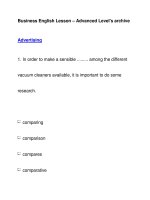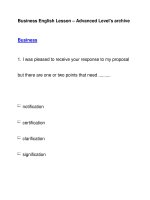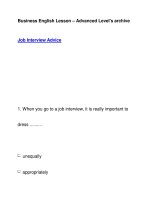Business English Lesson – Advanced Level''''s archiveSystem Development Life Cycle pot
Bạn đang xem bản rút gọn của tài liệu. Xem và tải ngay bản đầy đủ của tài liệu tại đây (77.59 KB, 10 trang )
Business English Lesson – Advanced Level's archive
System Development Life Cycle
1. As Russel Kay tells it, once a time, software
development consisted of a programmer writing code to
solve a problem or automate a procedure.
after
at
in
upon
2. Nowadays, systems are so big and complex that teams
of architects, analysts, programmers, testers and users
must work together to create the millions of lines of
written code that drive our enterprises.
custom
hand
machine
self
3. The system development life cycle models work well
when automating the activities of clerks and accountants,
but they don't work nearly as well when building systems
for workers — people at help desks, experts trying
to solve problems, or executives trying to lead their
company into the Fortune 100.
knowledge
sessile
think-tank
white-collar
4. The waterfall model assumes that the only role for users
is in specifying requirements, and that all requirements
can be specified in advance; unfortunately, requirements
grow and change throughout the process and beyond,
calling for considerable feedback and consultation.
indicative
insistent
iterative
itinerant
5. The fountain model recognizes that although some
activities can't start before others — such as you need a
design before you can start coding — there's a
considerable of activities throughout the
development cycle.
overflow
overlap
undertow
underuse
6. The spiral model emphasizes the need to go back and
earlier stages a number of times as the project
progresses; it's actually a series of short waterfall cycles,
each producing an early prototype representing a part of
the entire project.
recalibrate
regurgitate
reinstate
reiterate
7. In the rapid application development model, initial
emphasis is on creating a that looks and acts like
the desired product in order to test its usefulness.
genotype
holotype
phenotype
prototype
8. The model divides the product into builds, where
sections of the project are created and tested separately.
fractile
fractional
incidental
incremental
9. This approach will likely find errors in user requirements
quickly, since user feedback is for each stage and
because code is tested sooner after it's written.
extracted
insisted
queried
solicited
10. The synchronize and stabilize method combines the
advantages of the spiral model with technology for
overseeing and managing source code; this method
allows many teams to work efficiently in ; this
approach was defined by David Yoffie of Harvard
University and Michael Cusumano of MIT.
paradigms
parallax
parallel
paratroops









